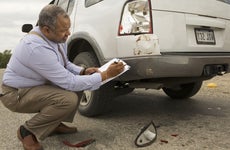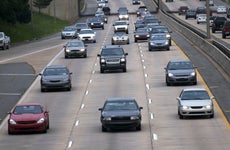Liability car insurance: what it covers and how much it costs

The Bankrate promise
At Bankrate, we strive to help you make smarter financial decisions. To help readers understand how insurance affects their finances, we have licensed insurance professionals on staff who have spent a combined 47 years in the auto, home and life insurance industries. While we adhere to strict , this post may contain references to products from our partners. Here's an explanation of . Our content is backed by Coverage.com, LLC, a licensed entity (NPN: 19966249). For more information, please see our .
Portions of this article were drafted using an in-house natural language generation platform. The article was reviewed, fact-checked and edited by our editorial staff.
Liability insurance is a mandatory part of car insurance in most states. When you are involved in an at-fault accident, liability coverage is what helps protect your finances and assets by covering the other party’s injury and vehicle expenses. In this article, we’ll break down the basics of liability insurance and offer helpful tips for finding the right coverage for you.
What is liability insurance?
Auto liability insurance is a specific type of car insurance coverage that covers injury and damage you cause in a car accident along with the cost to defend or settle lawsuits brought against you because of the accident.
It comes standard with car insurance policies and is sometimes referred to as auto liability coverage. To legally operate a vehicle, it’s required in almost every state to have liability insurance; however, even if you don’t live in a state that requires it, having this coverage can provide peace of mind and protection in the case of a future at-fault accident.
Keep in mind that only purchasing the minimum liability coverage levels required by your state could leave you vulnerable to potentially devastating financial loss if you cause an accident due to the ever-rising costs of medical care and litigation.
How liability insurance works
Auto liability coverage is typically broken down into two categories: bodily injury liability and property damage liability. Here’s what you need to know about both types of coverage and how they differ from one another.
- Bodily injury liability helps cover the cost of other parties’ injuries that you cause when you are at fault in an accident. This can include emergency care, continued medical costs and even lost wages.
- Property damage liability helps cover the cost of damage to other parties’ property when you are at fault in an accident. The most obvious example is vehicle damage, but other types of property include buildings, guardrails, utility poles and fences. Property damage liability does not cover damage to your own vehicle if you cause an accident.
What does liability car insurance cover?
Liability car insurance is designed to protect your finances if you cause an accident. It helps cover the medical expenses and property damage of the other driver and involved passengers, which is why most states require it.
Liability insurance coverage is a way to help prevent the at-fault driver or other affected people from being left with significant out-of-pocket expenses. It also helps the not-at-fault driver receive some level of compensation for suffering damage or injury that the accident was found to cause.
What does bodily injury liability cover?
Although every claim is unique, bodily injury coverage will generally cover the following categories:
- Emergency medical expenses, including an ambulance, an emergency room visit and hospital care
- Ongoing medical expenses, such as doctor visits and rehabilitation
- Lost wages
- Pain and suffering
- Funeral expenses
- Related legal expenses, like lawsuits and attorney and court fees
Also, remember that it only pays up to your policy’s limits. If the injured party’s medical expenses exceed your policy’s limit of bodily injury liability coverage, you may be responsible for the difference out of pocket.
What does property damage liability insurance cover?
Property damage liability coverage generally pays for:
- The other party’s vehicle damage
- Cost for the other party to rent a replacement vehicle while repairs are completed
- Damage to buildings, homes or businesses
- Damage to fences, mailboxes and other structures
- Lost business revenue due to physical storefront damage
- Related legal expenses, such as court and attorney fees
Your property damage liability coverage pays for damage caused by you to other people’s property. It does not help with damage to your own vehicle or damage to a vehicle owned by a family member who lives in the same household as you. To help cover repairs for your vehicle, you will need collision coverage.
Keep in mind that the expenses listed above are covered up to your policy limit. Any costs that exceed your policy limit may become your responsibility, even if you have liability insurance.
Example 2: In a different situation, imagine a driver’s vehicle is severely damaged due to a weather event, such as a hailstorm, where the cost of damage could vary significantly depending on the severity — potentially reaching upwards of $3,000 for extensive hail damage. In this case, liability insurance would not provide coverage for the loss or damage to the driver’s vehicle. To be protected in such circumstances, the driver would need collision or comprehensive coverage, which is designed to cover the cost of repairing or replacing the policyholder’s vehicle in the event of theft, weather-related damage or other non-collision incidents.
What doesn’t liability insurance cover?
While liability auto insurance covers most costs related to your liability in an accident, a few costs are not covered. For example, liability insurance will not cover damage caused by intentional acts. Your liability coverage also doesn’t cover any of the vehicles insured on your policy if they’re damaged from an accident.
To have your costs covered in this scenario, you’d need to rely on specific types of insurance, like comprehensive and collision insurance for your vehicle repair costs. Liability may also not cover injuries to passengers in your vehicle. Typically, personal injury protection or medical payments coverage step in to help cover your medical bills and those of people in your vehicle.
How much does liability insurance cost?
The average cost for minimum coverage auto insurance in the United States is $644 per year, while full coverage costs an average of $2,314 per year. While liability coverage does make up a portion of those premiums, your total car insurance costs will vary depending on where you live.
In addition to the state you live in, insurance companies use several individual factors to determine your insurance premiums, including:
- Your age (in most states)
- Type of car you drive and how many miles you log per year
- Your driving history
- Your ZIP code (in most states)
- Your credit-based insurance score (in most states)
- Coverage types and limits you choose to purchase
The cost of car insurance coverage in total is made up of an amalgamation of costs and factors; for example, the factors used to determine your premiums also can influence your individual coverage costs.
Plus, most companies give you a wide range of coverage limits and options to choose from. While higher limits will give you more coverage in the case of an at-fault accident, they’ll increase your monthly cost, as higher limits generally increase your premiums.
Learn more: Cheap liability-only car insurance
How to calculate the amount of liability insurance you need
Everyone has different insurance needs, but you can use some general guidelines to help determine how much coverage you may need. Costs that exceed your coverage limits may become your responsibility, and the more assets you own, the more liability insurance you may need.
It’s generally thought that you’ll want to have liability insurance that at least covers your net worth; however, consulting a licensed insurance professional is always a good way to determine how much coverage you really need.
Understand your state’s insurance laws
The minimum coverage you need depends on the state you reside in and whether it is a no-fault or tort state (states that hold drivers responsible for damage and injuries caused to others). In a no-fault state, in addition to liability, property damage and bodily injury coverage, a driver may also be required to carry personal injury protection. Uninsured and underinsured motorist coverage may also be required.
In most states, you will need to purchase at least your state’s minimum required liability limits to legally drive, and these required limits vary by state. It’s useful to know your state’s minimum liability limits when looking at coverage and policies, but it’s not required that you know them by heart. Car insurance companies cannot sell you a policy that does not meet or exceed what’s required in your state.
When viewing required liability coverage types, you will see three numbers separated by a forward slash.
- The first number is the minimum bodily injury liability required per person in thousands
- The second number is the minimum bodily injury liability required per accident in thousands
- The third number is the minimum property damage liability required in thousands
So when you see 25/50/25 for Alabama, that means if you live in Alabama, you must carry at least $25,000 of bodily injury liability per person, $50,000 of bodily injury liability per accident and $25,000 of property damage liability.
These are just the minimum required coverage options so most insurance professionals will recommend that you carry higher liability limits if you can afford to do so to provide yourself with a greater level of financial protection.
Think about your financial situation
Although generally mandatory, car insurance may seem unnecessary for those on a tight budget. However, paying a few hundred dollars a year for at least the minimum coverage can save you from greater financial strain. For instance, if you crash your car into someone else’s property and are sued for the damages, those expenses can be far steeper than your insurance premium. Not having auto insurance could also open you to state penalties and the risk of driver’s license and vehicle registration suspension.
Canceling your insurance or a lapse in coverage could also make you a high-risk customer and result in more expensive premiums later on. Therefore, instead of forgoing insurance, look for an affordable insurer and available discounts to keep your costs low.
Consider your net worth
How much liability insurance you need will also depend on your net worth. If you have a significant amount of assets — such as a house, car or sizable savings account— and not much debt, you may want to purchase more liability insurance to cover your net worth and prevent assets from being taken in a judgment. You may even consider an umbrella insurance policy to provide extra liability coverage above typical standard car insurance policy limits.
Best providers for liability insurance
Because everyone has different insurance needs, the best car insurance company will vary for every driver. The following companies, chosen by market share, have available discounts and third-party rankings worth considering:
| Car insurance company | Average annual premium for minimum coverage (to meet state liability requirements) |
|---|---|
| USAA | $434 |
| Geico | $459 |
| Progressive | $571 |
| Allstate | $677 |
| State Farm | $702 |
Each provider listed has various discounts that may help reduce the cost of annual premiums. When shopping for car insurance, one of the best ways to find the right policy for you is to obtain quotes for the same types of coverage and policy limits from several providers and compare them.
What is the difference between liability insurance and other types of car insurance coverage?
Liability insurance helps pay for the medical expenses and damage caused to the other driver, their passengers and their property. However, it does not pay for your vehicle damage or your injuries if you were the at-fault driver. To financially protect yourself from a broader range of scenarios, you may want to consider purchasing the following types of optional insurance coverage, as well:
- Comprehensive coverage: This pays for damage to your own vehicle caused by weather events, fire, theft, vandalism or striking an animal.
- Collision coverage: This pays for damage to your vehicle caused by crashes and collisions with other vehicles or objects.
- Uninsured/underinsured motorists coverage: These coverage options pay for injuries caused by a motorist with little to no insurance coverage and may help in the case of a hit-and-run. These insurance types are often required as part of state minimums, although they can be declined in writing in some states. Uninsured motorist coverage for property damage is available in some states from some insurance companies.
- Roadside assistance coverage: This helps pay for expenses in instances where your vehicle breaks down or needs a tow. It can also help if you have a dead battery and need a jump or lose your keys.
- Car rental coverage: This covers the expenses for a rental vehicle while your car is in repair after a covered incident up to certain limits, typically for up to 30 days.
- Gap insurance: This pays for the outstanding loan amount on a financed vehicle if it is totaled or stolen before the loan or lease has been paid off.
There are numerous car insurance coverage options, and each insurance company offers its own suite of available coverage. Talking to a licensed insurance agent about your policy may be the best way to determine what coverage options you should purchase.
Frequently asked questions
-
-
No, liability insurance does not cover your car if someone hits you. Your liability insurance covers the other person if you hit them, so if someone hits you, their liability insurance should cover your damages and injuries up to their policy limits. If someone who does not have car insurance or enough coverage hits you, having uninsured/underinsured motorist coverage helps financially protect you from incurred losses.
-
Even if you have liability insurance, your assets may still be at risk if you cause an accident, especially if you only purchase your state’s minimum required amount of coverage. Once your car insurance policy liability limits are exhausted, the claimant may be able to hold you financially liable for any overage. For instance, if the claimant is awarded $300,000 in damages, but your policy limit maximum is $250,000, you may be required to pay the remaining $50,000. If you need more coverage than your auto policy can provide, consider a personal umbrella policy to increase your liability coverage.
-
It is normal for the other driver to file a claim if you cause an accident. An insurance adjuster will contact you to discuss the accident after the claim has been filed. If they determine you are at fault, your auto policy will pay based on injuries and damages from the accident, and according to your selected coverage, up to the policy limit. Once the claim is finalized, you may see an increase in your premiums upon your next policy renewal for causing an accident. This is typically in the form of a multi-year surcharge added to your premium renewal. You might be able to avoid an increase if you carry accident forgiveness coverage and it is your first at-fault accident.
-
Driving without liability insurance is illegal in almost every state and can result in various penalties ranging from fines, license suspension, vehicle impoundment and even jail time, especially for repeat offenders or in severe situations. Additionally, driving without insurance can lead to higher future car insurance rates. The specific penalties vary by state, and in some cases, you could be held personally liable for property damage and injuries if you cause an accident while uninsured.
-
Methodology
Bankrate utilizes Quadrant Information Services to analyze April 2024 rates for all ZIP codes and carriers in all 50 states and Washington, D.C. Rates are weighted based on the population density in each geographic region. Quoted rates are based on a single, 40-year-old male and female driver with a clean driving record, good credit and the following full coverage limits:
- $100,000 bodily injury liability per person
- $300,000 bodily injury liability per accident
- $50,000 property damage liability per accident
- $100,000 uninsured motorist bodily injury per person
- $300,000 uninsured motorist bodily injury per accident
- $500 collision deductible
- $500 comprehensive deductible
To determine minimum coverage limits, Bankrate used minimum coverage that meets each state’s requirements. Our base profile drivers own a 2022 Toyota Camry, commute five days a week and drive 12,000 miles annually.
These are sample rates and should only be used for comparative purposes.
Related Articles




